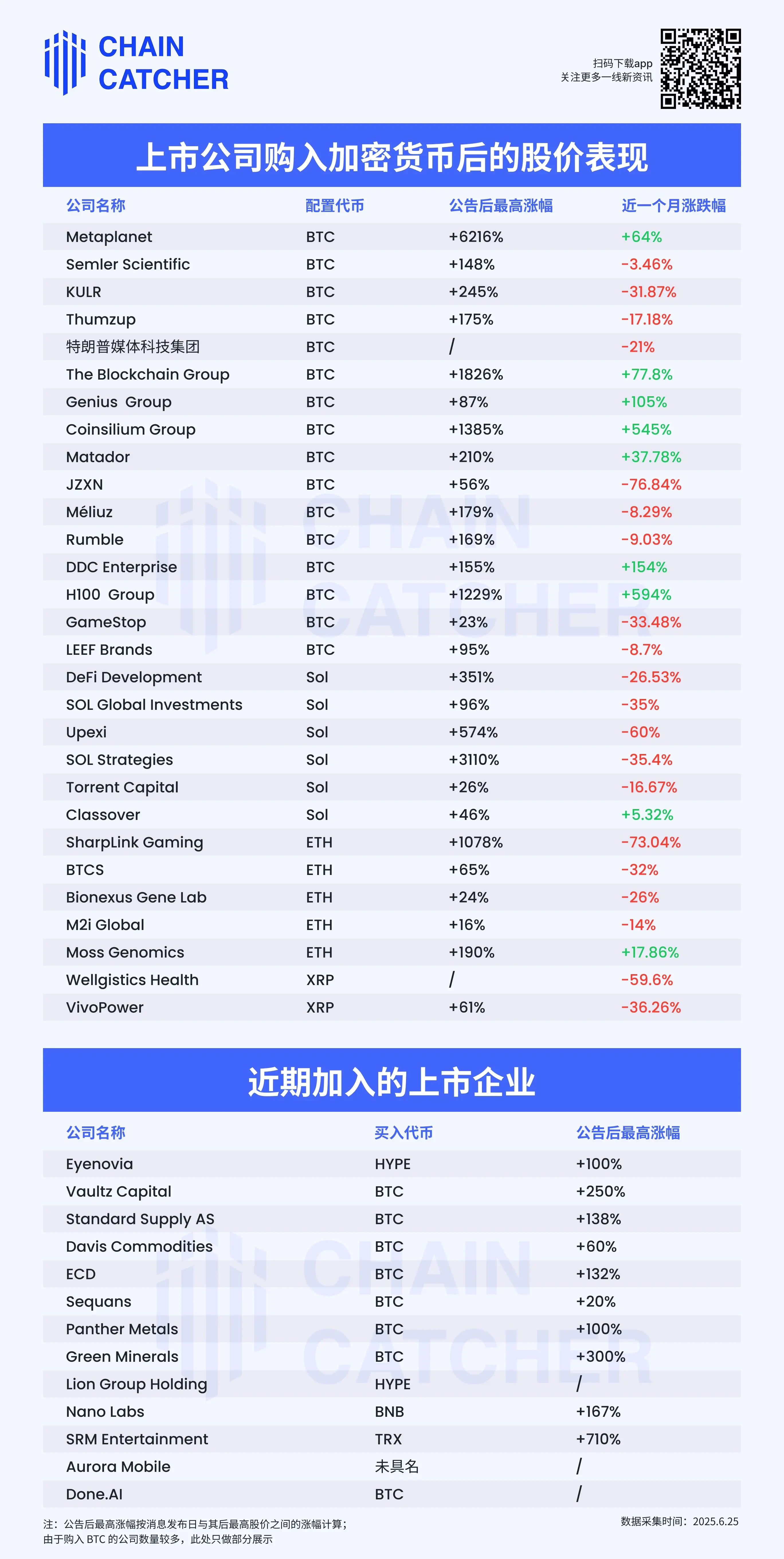U.S.-listed companies are flocking to “buy cryptocurrencies”, how effective will the second growth curve be?
Original author: Fairy, ChainCatcher
Original editor: TB, ChainCatcher
Buying coins has become a cheap and quick way to increase market value in the stock market.
The U.S. stock market is in the midst of a copycat season boom, with the main businesses of listed companies becoming a foil, and digital assets becoming a new engine of market value.
But the problem is becoming more and more acute: Will the market really continue to buy into this valuation game in the name of borrowing money?
Valuation logic: How does buying coins affect corporate value?
Buying coins is like a valuation deviation experiment interwoven with emotions, liquidity and narratives.
In the traditional valuation framework, the market value of a company is derived from the comprehensive pricing of core variables such as its profitability, asset-liability structure, growth potential and free cash flow. However, in this round of coin buying, companies leveraged the markets re-pricing of their valuations by holding کرپٹو assets as financial configuration.
When companies include Bitcoin or other mainstream crypto assets in their balance sheets, the markets valuation of them is attached with a premium multiple based on the price elasticity and trading expectations of crypto assets. In other words, the market value of a company comes not only from value creation, but also from the leveraged amplification of the possibility of coin price increases.
However, this structure almost places the liquidity narrative above business operations and alienates financial configuration into the main axis of capital operations.
Short-term boost, long-term question mark
It is undeniable that entering the crypto space does have the ability to stimulate stock prices in the short term. Take Cango, an auto trading service provider, for example. In November 2023, the company announced its entry into the Bitcoin mining field, spending $400 million to purchase 50 EH/s of computing power resources, and then its stock price soared 280%. Similarly, there are many companies whose main business performance is mediocre or even in financial difficulties, and they are also trying to seek revaluation in the capital market with the help of the buy coin narrative. (Related reading: The rise of the micro strategy version of ETH and SOL: a new hype script driven by the dual wheels of coins and stocks? )
We have compiled a batch of stock price data of listed companies that have achieved coin-stock linkage by purchasing cryptocurrencies:

Judging from the market performance, the phenomenon of buy coins and the price will soar has been staged many times. As long as the concept of crypto assets is promoted, short-term funds will quickly pour in. However, after the short-term surge, many coin holding companies are facing a stock price correction. Without continuous purchases of coins or other positive news, the increase will be difficult to maintain.
Therefore, although the coin buying strategy can stimulate market enthusiasm in the short term, whether it can be transformed into long-term competitiveness and sustained growth of enterprises is still full of uncertainty. It is also difficult for the market to truly recognize those followers who only purchase coins once or twice or have vague coin holding plans to attract attention.
Are speculators starting to sell?
The story of buying coins to increase valuations continues to ferment, but some core players seem to be quietly taking profits.
Strategy, the originator of the unlimited growth theory, has been selling its shares of $MSTR. According to SecForm 4.Com data, Strategy insiders have been selling shares since June 2023. Protos reported that in the past 90 days alone, executives have sold a total of $40 million in shares, with sales 10 times the number of purchases.

Image source: secform 4.com
Upexi, the Sol version of MicroStrategy, has also been under pressure recently. The company previously raised $100 million to set up the Sol Treasury. However, Upexi plunged 61.2% yesterday as investors registered to sell 43.85 million shares, equivalent to its total initial outstanding shares in April. (Related reading: SOL returns to $150, Upexi becomes Solana version of MicroStrategy, is unlimited growth about to begin? )
On the other hand, the stock price of stablecoin issuer Circle soared to nearly $300 after its listing. However, Ark Invest, which had strongly supported Circle before its listing, continued to reduce its holdings. It is reported that Ark Invest has sold Circle shares four times in a row, reducing its holdings by more than 36%.

When buying coins becomes a packaging, a market value tool, or even a narrative shell to avoid fundamental questioning, it is destined to not become the pass key for all companies. Todays market is willing to pay for financial configuration, but tomorrows market may return to the real questioning of growth and profitability.
The buying orders in the secondary market are not necessarily recognition; it is more likely to be the rotation of chips for short-term speculation.
This article is sourced from the internet: U.S.-listed companies are flocking to “buy cryptocurrencies”, how effective will the second growth curve be?
Original author: ChandlerZ, Foresight News As the full-scale conflict between Israel and Iran continues to escalate, the cyber battle line has quietly extended to the encryption field. The mysterious hacker group Gonjeshke Darande (Persian for predatory sparrow) claimed that it had launched a large-scale attack on Nobitex, Irans largest cryptocurrency trading platform, and successfully obtained its source code, internal network data, and customer asset data. So far, nearly $82 million in crypto assets have been affected, most of which are stablecoins such as USDT. Although Tether has the ability to freeze the suspected addresses, according to on-chain data, most of the funds remain in the original accounts and there seems to be no immediate plan to transfer or launder the money. This stagnation behavior is interpreted by the community as…




